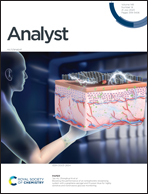An adaptive three-dimensional hydrodynamic focusing microfluidic impedance flow cytometer†
Abstract
Microfluidic impedance cytometry is emerging as a label-free, low-cost and portable solution for cell analysis. Impedance-based cell or particle characterization is provided by microfluidic and electronic devices. We report the design and characterization of a miniaturized flow cytometer based on a 3-dimensional (3D) hydrodynamic focusing mechanism. A sheath adaptively concentrated the sample laterally and vertically at the bottom of the microchannel, reducing the variance of particle translocation height and increasing the signal-to-noise ratio of the particle impedance pulse. Through simulation and confocal microscopy experiments, it has been verified that an increase in the ratio of sheath to sample decreased the cross-sectional area of the concentrated stream, which can be reduced to 26.50% of the pre-focusing value. The appropriate sheath flow settings increased the impedance pulse amplitude for different particles, and the coefficient of variation reduced by at least 35.85%, contributing to a more accurate representation of the particle impedance characteristic distribution. The system displayed the difference of HepG2 cell impedance before and after drug treatment, which is consistent with the results of flow cytometry, providing a convenient and inexpensive solution for monitoring cell status.

- This article is part of the themed collection: Analyst HOT Articles 2023


 Please wait while we load your content...
Please wait while we load your content...